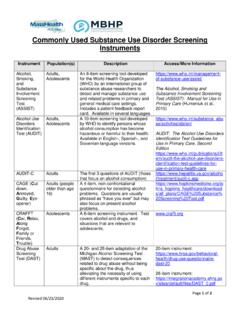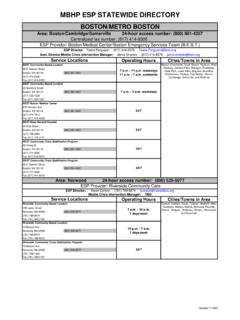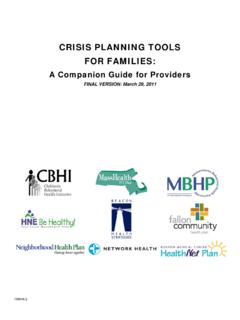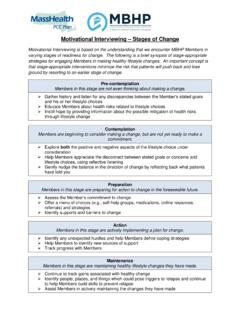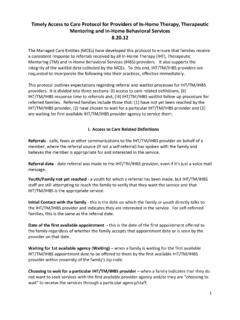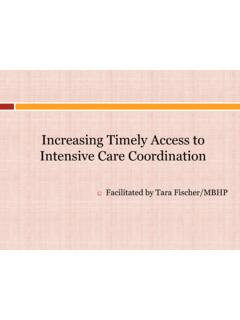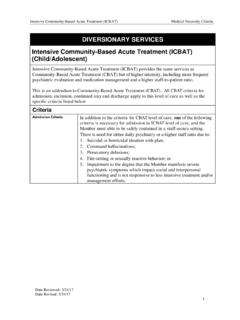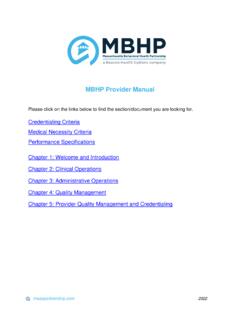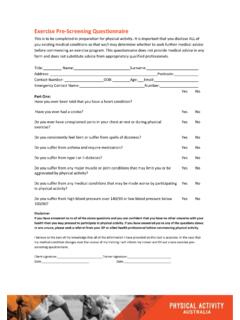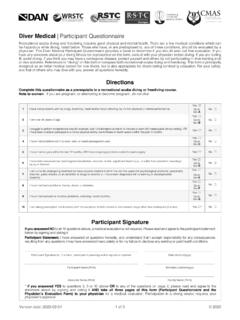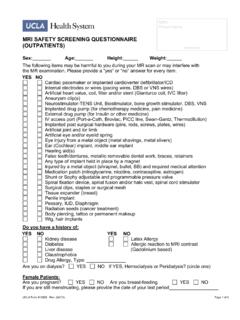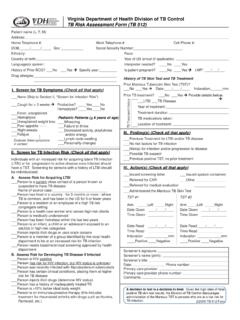Transcription of Adolescent Screening, Brief Intervention, and Referral to ...
1 Provider Guide March 2009. Adolescent screening , Brief Intervention, and Referral to Treatment for Alcohol and Other Drug Use Using the CRAFFT screening Tool Massachusetts Department of Public Health Bureau of Substance Abuse Services Provider Guide Table of Contents The problem of Adolescent alcohol and other drug use Page 2. The CRAFFT screening Tool Page 3. Brief advice/intervention Page 8. Referral and follow up Page 13. Stopping substance abuse before it starts Page 16. Appendix A: CRAFFT. screening Questions Page 18. Appendix B: Contract for Life Page 19. Appendix C: Abstinence Challenge Page 20. CRAFFT Algorithm Back Cover 1. Welcome Adolescent primary care providers! Research shows that many health care providers feel that they have inadequate tools, training, time, and treatment resources for alcohol and other drug use screening and Brief intervention for all Adolescent Because physicians are uniquely positioned to influence Adolescent substance use, the American Academy of Pediatrics recommends that pediatricians provide alcohol screening and counseling to all adolescents, as well as children in upper elementary ,3 Additionally, MassHealth For more information now requires primary care providers to offer to complete the behavioral about specific drugs health screening component of Early and Periodic screening , Diagnosis (including prescription and Treatment (EPSDT) and the Preventive Pediatric Healthcare screening and Diagnosis (PPHSD))
2 Well child visits for MassHealth medications that can members under the age of 21 using an age-appropriate, standardized be abused), commonly- behavioral health screening tool selected from a menu of tools approved used names, and health by MassHealth. effects, please reference The menu includes the CRAFFT (CAR, RELAX, ALONE, FORGET, FRIENDS, TROUBLE) for adolescents aged 14 and older. The CRAFFT, the featured screening tool in this guide, is a series of 6 questions gov/DrugPages/. developed to screen adolescents for high-risk alcohol and other drug use , disorders simultaneously. from the National MassHealth also requires providers to provide or refer members to Institute on Drug Abuse. assessment, diagnosis, and treatment services if the standardized behavioral health screen indicates that the member has a behavioral health need.
3 This kit provides the resources you will need to efficiently incorporate the CRAFFT, Brief advice, and referrals for further evaluation and treatment for alcohol and other drug use into routine Adolescent visits. 2. The Problem of Adolescent Alcohol and Other Drug Use The majority of adolescents have used alcohol or another drug by the time they have reached 12th grade. Alcohol is the most commonly used drug among adolescents4 and is responsible for more mortality and morbidity in this age group than all other drugs Use typically begins during early adolescence, with peak initiation during grades 7 through 9. By the 12th grade, 80% of high school seniors report having used alcohol, 62%. report having gotten drunk, and 31% report heavy episodic Among adolescents who drink alcohol, 38% to 62% report having had problems related to their drinking,6 such as interference with work, emotional and psychological health problems, the development of tolerance, and the inability to reduce the frequency and quantity of use.
4 Parents' tobacco use is related to their children's early tobacco co Tobac use, and puts them at greater risk for early substance use. In fo Visit for free information to help families quit smoking. The case scenarios in this guide provide examples of the varying types of advice providers give and follow up they arrange based on an Adolescent 's screening Case Studies CRAFFT screening . While the cases provide some sample dialogues, we recommend that each provider use his/her own style when communicating with adolescents. The case scenarios in this Provider Guide are fictional and the associated photos are not intended to represent the person in the case scenario. 3. The CRAFFT screening Tool Every Adolescent should be asked yearly about use of alcohol and drugs. An easy way to remember how to screen adolescents for psychosocial problems is to use the mnemonic HEADSS (home, education and employment, activities, drugs [including tobacco and alcohol], sex, suicidality/depression) 8 psychosocial interview, which is included in the American Medical Association's Guidelines for Adolescent Preventive Services.
5 9. The most frequently used substance abuse screening tool in Massachusetts is the CRAFFT. The CRAFFT is a series of 6. questions developed to screen adolescents for high-risk alcohol and other drug use disorders simultaneously. It is a short, effective screening tool meant to assess whether a longer conversation about the context of use, frequency, and other risks and consequences of alcohol and other drug use is warranted. (See Appendix A.). 4 The CRAFFT is a MassHealth-approved Using the CRAFFT screening tool behavioral health screening tool for use with screening using the CRAFFT begins by asking children under the age of 21 and is recommended the Adolescent to Please answer these next by the American Academy of Pediatrics' questions honestly ; reminding him/her of your Committee on Substance Abuse for use with office confidentiality policy; and then asking 3.
6 Adolescents. It was developed by modifying opening questions. promising questions from longer screens ( , qualify with ever ; screen for drugs as well as During the past 12 months, did you: alcohol), combining similar questions, and then 1. Drink any alcohol (more than a few sips)? assessing concurrent validity to identify the best questions for identifying adolescents who need 2. Smoke any marijuana or hashish? substance abuse The sensitivity of the CRAFFT is similar to the longer AUDIT 3. Use anything else to get high? and POSIT tests', and much greater than that of CAGE (which is not recommended for use ( Anything else includes illegal drugs, over with adolescents).11 The CRAFFT works equally the counter and prescription drugs, and well for alcohol and drugs, for boys and girls, things that you sniff or huff.)
7 For younger and older adolescents, and for youth from diverse race/ethnicity backgrounds. Figure 1: CRAFFT is a mnemonic acronym of first letters of key words in the 6 screening questions. The questions should be asked exactly as written. C Have you ever ridden in a CAR driven by someone (including yourself) who was high or had been using alcohol or drugs? R Do you ever use alcohol or drugs to RELAX, feel better about yourself, or fit in? A Do you ever use alcohol or drugs while you are by yourself, or ALONE? F Do you ever FORGET things you did while using alcohol or drugs? F Do your family or FRIENDS ever tell you that you should cut down on your drinking or drug use? T Have you ever gotten into TROUBLE while you were using alcohol or drugs? 5. John: A 19-year old young man presented to the school-based health center with flu-like symptoms and the nurse practitioner asked the 3 CRAFFT opening questions.
8 John replied that he had used alcohol, marijuana, and other drugs during the past 12. months. The nurse practitioner asked the CRAFFT questions and documented that John responded Yes to all 6 questions. She then called the covering physician to discuss how to respond to John's CRAFFT total score of 6. If the Adolescent answers No to all 3 opening Those who report any use of alcohol or drugs questions, the provider only needs to ask the and have a CRAFFT score of 0 or 1 should be Adolescent the first question the CAR question. encouraged to stop and receive Brief advice If the Adolescent answers Yes to any 1 or more regarding the adverse health effects of substance of the 3 opening questions, the provider asks all use. A score of 2 or greater is a positive screen 6 CRAFFT questions.
9 (See Figure 1.) and indicates that the Adolescent is at high-risk Each Yes response to the CRAFFT questions for having an alcohol or drug-related disorder is scored 1 point. Adolescents who report no use and requires further assessment. (See attached of alcohol or drugs and have a CRAFFT score CRAFFT algorithm at the end of this guide.). of 0 should receive praise and encouragement. For a downloadable, self-administered version of the CRAFFT and to order pocket-sized CRAFFT cards for office use, visit You may wish to integrate the CRAFFT screening questions into your electronic health record (EHR) template. Be sure to include the responses to the individual CRAFFT questions in addition to the final assessment if relying on the EHR to capture the data. Speak to your medical records department about ensuring the confidentiality of these data in accordance with federal regulations.
10 (See Confidentiality section on page 16.). The CRAFFT in Spanish, Portuguese, Hebrew, French, Czech, Khmer, Russian, Vietnamese, Haitian Creole, Laotian, Chinese, and Japanese will be available by June 2009 at 6. Sarah: A 14-year old girl presented for an annual physical examination required for participation in her school's fall sports program. She completed the paper CRAFFT. screening questionnaire . She answered No to all 3 opening questions and No to the CAR question. The practice receptionist then placed the completed questionnaire in Sarah's folder for her physician to review. Options for implementing screening Option 2: The physician or nurse practioner in your practice can ask the opening questions and CRAFFT. The CRAFFT tool can be administered in screening questions of Adolescent patients.
